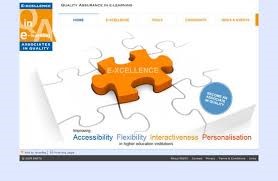This module provides an introduction and overview of the quality enhancement framework. You will learn more about quality characteristics and decisive dimensions of quality-relevant topics in blended learning courses. Finally, you will learn about some overarching considerations about quality enhancement and the importance of involving all stakeholders and taking a holistic approach.
In this project benchmarking is used as a framework for quality improvement. In our approach, benchmarking is an improvement tool and the practice and process of comparing the performance of organizations/schools with the best practices in the field, in this case, blended learning/e-learning.
A benchmarking approach is based on self-evaluation in the first step of the references and is therefore much more suitable, effective, and sustained. Typical parameters are quality, time and cost. This process is used in management where organizations/schools evaluate different aspects of their processes in relation to the processes of best practice, usually within a peer group defined for comparison. The benchmarking approach to measuring performance uses specific indicators that lead to a key performance indicator
that is then compared with others. This enables organizations/schools to develop plans to make improvements or customize specific best practices, often with the goal of improving part of the performance. Benchmarking can be a one-off event but is often treated as a continuous process in which organizations/schools constantly strive to improve their practices. The method is also referred to as "best practice benchmarking" or "process benchmarking", In our case, the EADTU e-xcellence benchmarking approach is used as a framework.
 The use of EADTU E-xcellence quality associates label in this context has been done with the agreement and consent of the European Association of Distance Teaching Universities (EADTU). In case of any adaption of the benchmarks suiting the context is in comments below the original benchmark. The original framework is available at https://e-xcellence.eadtu.eu/
The use of EADTU E-xcellence quality associates label in this context has been done with the agreement and consent of the European Association of Distance Teaching Universities (EADTU). In case of any adaption of the benchmarks suiting the context is in comments below the original benchmark. The original framework is available at https://e-xcellence.eadtu.eu/
The framework has its foundation in the EADTU E-xcellence Quality Associates Label,. E-xcellence aims at benchmarking and best practice. The Manual for E-Excellence is based on extensive international research and practice. The E-xcellence Framework has been used mainly in Europe for more than 10 years, but is now also in use worldwide, and covers even now blended learning, OER, MOOC, and the use of social media.
The E-xcellence Benchmarking Framework comprises three areas with a total of six dimensions (Ossiannilsson, 2012; Ossiannilsson, WIlliams, Camelleri and Brown, 2015), Figure 2. The three areas are Services (Capacity building/Human Resources/Staff Support and Student Support), Products (Curriculum Design, Course Design and Delivery) and Management (Strategic Planning and Development). In addition, accessibility, flexibility, interactivity and personalization are emphasized within the framework.
Aims of this unit
On completing this module, you will be able to:
- Identify important quality dimensions and characteristics for blended learning.
- Check the quality parameters of a blended course.
- Implement a solid quality framework for your courses.
- Learn more about the involvement of stakeholders in quality enhancement in an organization
Timing
|
Activity |
Time frame |
Comments |
|
Interacting with the unit contents and do the self-evaluation activities provided along with these contents |
2 hours |
|
|
Doing the assignment(s) of the unit |
1 hour |
No assignment forseen |
|
Taking the online test of the unit |
20 minutes |
|
|
Total |
3 - 4 hours |
Bear in mind that this timing is just an average estimate. The real timing will depend on the personal circumstances of the learner.
Tips and recommendations
- You can use the printable version of these contents to underline them, take notes, draw diagrams, etc., but you should also take into account the multimedia contents of the unit (videos, audio, interactive exercises, etc.) that will not appear in the printed version.
- The comprehensive reading of the case studies will help you to better understand the contents and to place yourself in the professional context in which those contents are put into practice.
- Before carrying out the task, read the unit carefully.
- Check the provided videos from EADTU.
- Check the self-evaluation tool from EADTU.